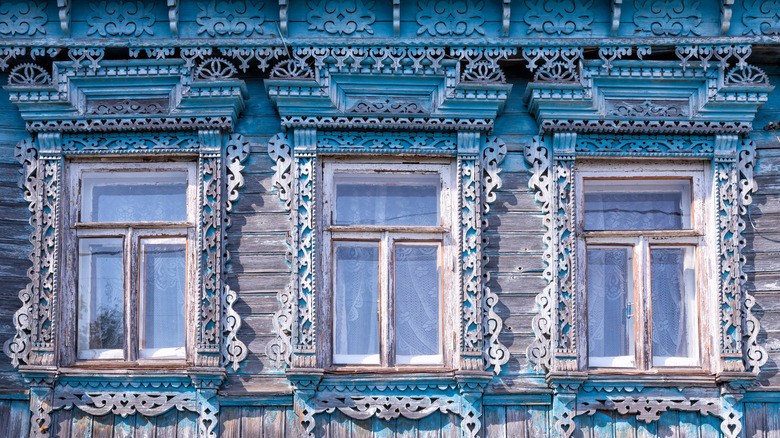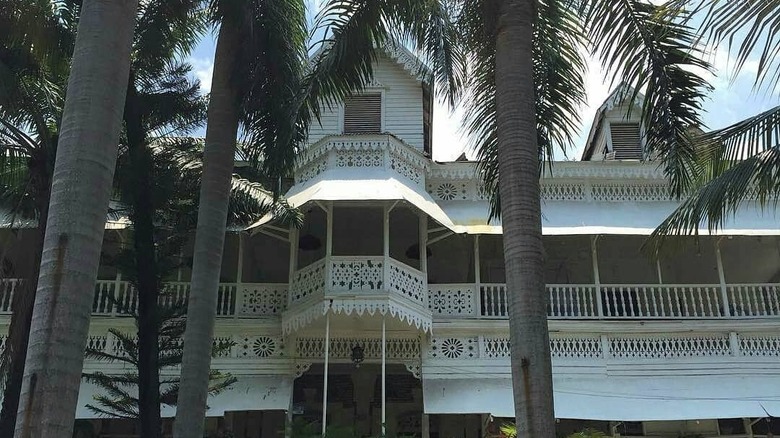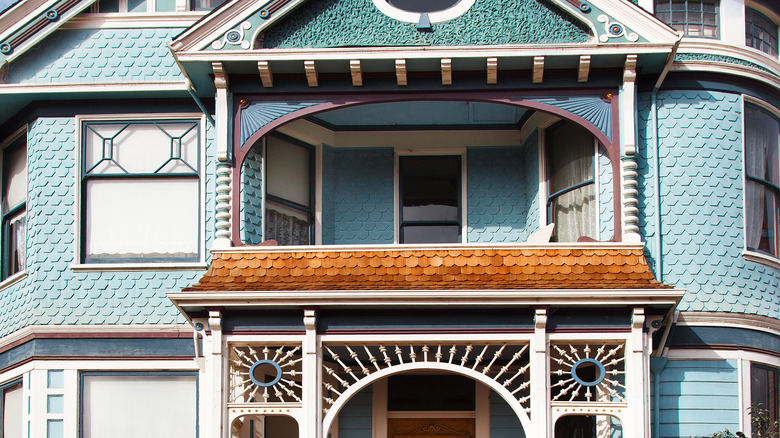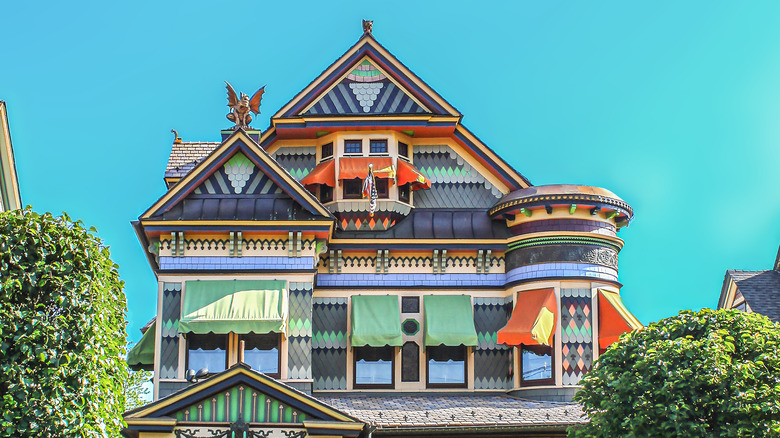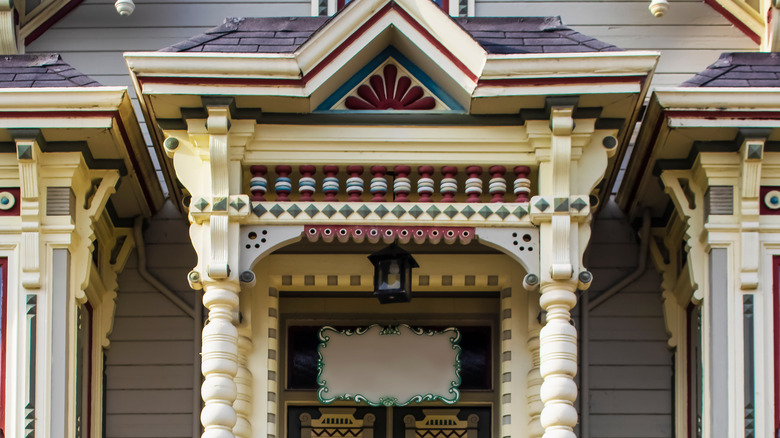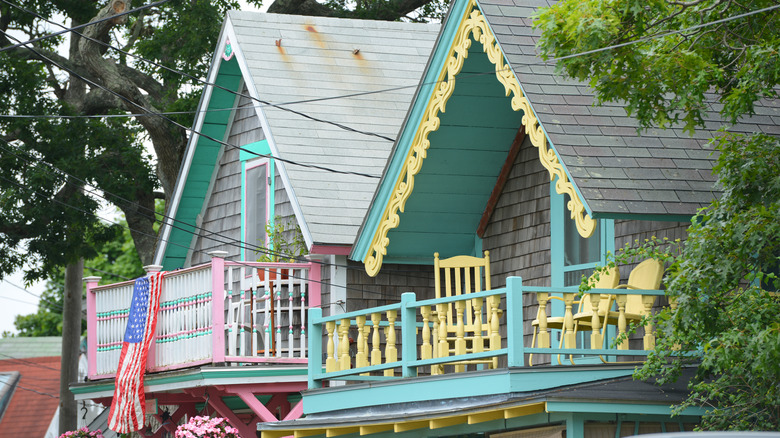What To Know About Gingerbread-Style Homes
Most of us are familiar with gingerbread houses as the delicious cookie-based confections that crop up everywhere around the holiday season, but did you know that gingerbread homes are a real architectural style too? The results are just as sweet-looking as their edible counterparts but blown up to a life-size scale. Although real-life gingerbread houses tend to have significantly fewer gumdrops, they make up for it with their charming and intricate ornamental latticework that resembles a baker's steady-handed swirls of elegant icing.
According to West and Main, the characteristics that define the gingerbread style are steeply pitched roofs, elaborate millwork, and scroll and lace-like designs elaborately covering the house's facade. This fanciful style of trim is most frequently found on Victorian homes between the late 1830s and the turn of the century. "It's not a standard cookie-cutter house, but one that evokes a magical emotion and whimsical flare," real estate broker Lacey Power said per the West and Main article.
They have history in Haiti
Back in 1895, three Haitian architects named Georges Baussan, Léon Mathon, and Joseph-Eugène Maximilien traveled to Paris and came back inspired by the French architecture that they saw there (via Visit Haiti). When they returned, they combined the Parisian style of architecture with characteristics suited to the hot climate with their own cultural flair. The result was a surge of colorful Victorian Gothic-style houses, which were resided in by the country's most well-to-do. They featured tall ceilings, turret roofs, wraparound verandas, and intricate trim, sometimes incorporating symbols associated with Haitian Vodou into the detailed decorations.
When the 1950s and 1960s came around, Haiti was a popular travel destination, and American tourists began referring to the distinctive homes as "gingerbread houses." Needless to say, the name stuck. Celebrities like Truman Capote and Katherine Dunham were known for vacationing in the flamboyant abodes or staying at the famous gingerbread-style hotel, Hotel Oloffson.
They are sturdy architectural marvels
The gingerbread-style houses in Haiti do more than look pretty — they are smartly designed wonders of architecture. The combination of soaring ceilings and turret roofs draws heat upwards, while the tall windows lining the homes allow for efficient airflow, creating a cleverly designed method of cooling (way before air conditioning was a thing!).
The colorful structures also have a hidden superpower: they are impressively resistant to natural disasters due to the flexible wood frames used to construct them. According to the Wall Street Journal, that special characteristic allowed roughly 95% of Port-au-Prince's gingerbread-style houses to remain intact through the devastating January 2010 earthquake, compared to about 60% of the rest of the buildings in the capital city. The credit for their long-term sustainability is undoubtedly due to the architects who designed them. "In an environment like this, nothing sticks around for 100 years by accident," Haitian Education and Leadership Program founder Conor Bohan told the Wall Street Journal.
They are an official heritage site
Local arts organizations currently provide most of the financial support to restore and care for the historic gingerbread houses of Haiti, per Visit Haiti. These groups ensure that the community and visitors alike can enjoy and learn about this charming aspect of Haitian culture and history, although that isn't the only reason people are investing time and money into protecting them. "The ultimate goal," World Monuments Fund director Erica Avrami said, "is to utilize preservation as a catalyst for urban planning, economic and community development, and heritage advocacy," per Architectural Record.
According to Visit Haiti, the cultural significance of these architectural beauties in combination with their degradation and lack of funding led to their inclusion on the 2010 World Monuments Watchlist in order to protect and raise attention to them. In 2020, the Haitian gingerbread houses were once again selected for the list of at-risk heritage sites. "These remarkable sites demand sustainable, community-driven solutions that bring people together and combine conservation and social change," the CEO of the World Monuments Fund explained (via Visit Haiti).
Inventions of the 1800s made them possible
Gingerbread-style homes were not possible to build prior to the mid-1800s when the steam-powered scroll saw and lathe became easily accessible and allowed for parts to be mass-produced, according to Canby Museums. The introduction of this technology allowed for the creation of intricate brackets, swags, and decorative elements iconic to the gingerbread trim. Once the technology made it possible to easily reproduce this style, many jumped at the chance to personalize their abodes with the ornate trim.
Railroad expansion across the United States also made it easier and cheaper to obtain the architectural materials necessary for the gingerbread trim, making the style more accessible to the masses. The increase in mass-produced paint around this time likewise allowed the style to develop its signature candy-hued bright coloring, used to add contrast and emphasis to the delicate icing-like details. The trend remained en vogue all the way until the advent of the Great Depression, when it was largely deemed too frivolous to maintain.
You can visit some famous examples
Although Haitian gingerbread houses have unique characteristics and are perhaps the most iconic, the style is also prominently found in some areas of the United States, Canada, and Thailand. In the U.S., the fanciful style is notably found in Cape May, New Jersey, where a blazing fire damaged much of the town in 1878. When rebuilding the town, most of the buildings were erected in Victorian gingerbread style (via Old House Journal). Today, walking along the streets of the coastal town will bring you back in time to the intricate and colorful styles of the 19th century.
In Haiti, some of the famous houses are open to the public, such as Villa Kalewès, a gingerbread-style mansion that now operates as an art gallery. It features brown wood siding and white lace trim, making for a truly striking similarity to its edible counterpart (via Visit Haiti). You could also check out the aforementioned Hotel Oloffson — even if you aren't staying as a guest, you can grab a bite at their restaurant amidst true Victorian gingerbread-style details.
